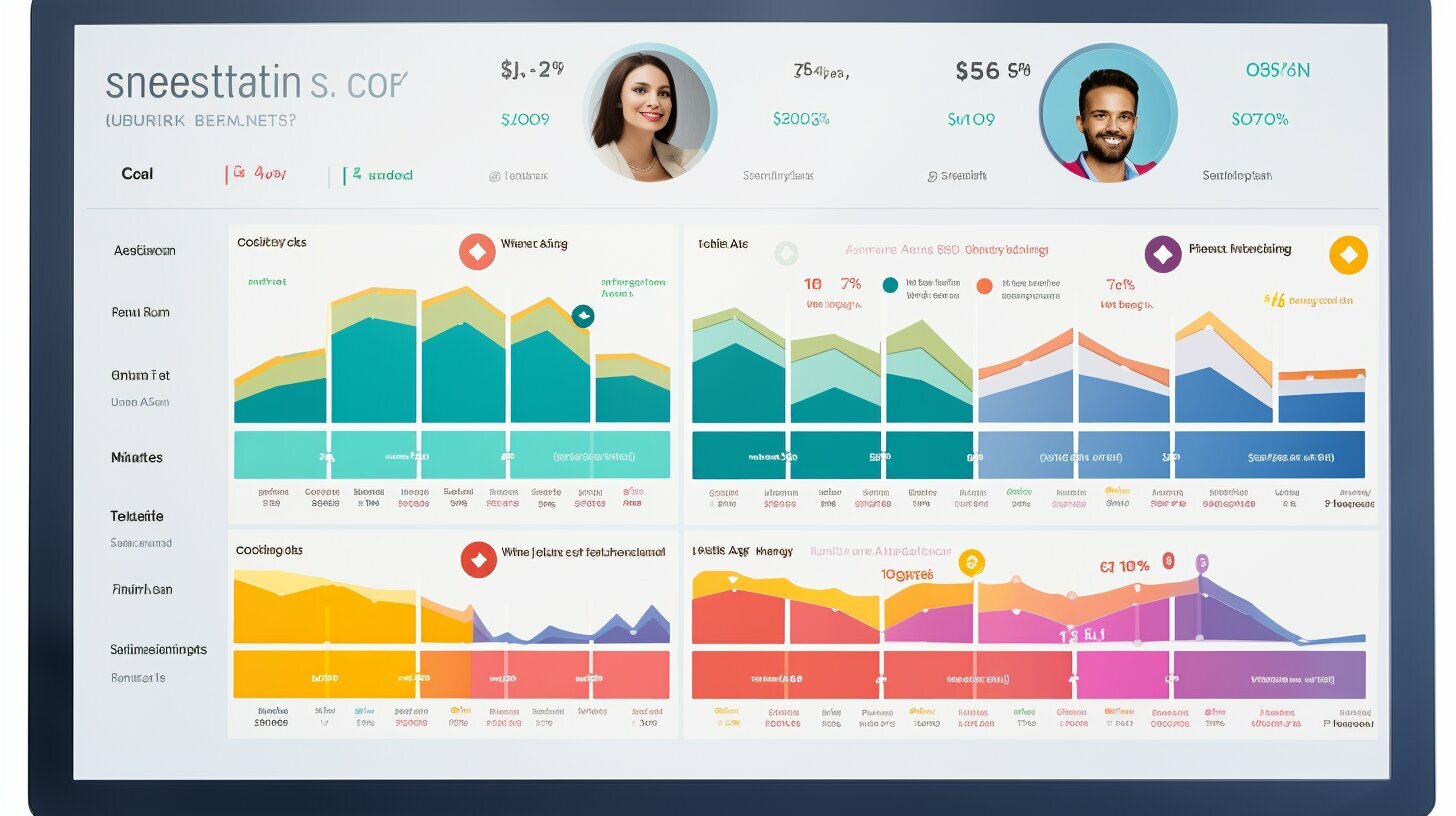As a sales manager, achieving sales targets is a primary goal. However, managing a sales team and tracking individual performance can be challenging. That’s where the digital sales leaderboard comes in. This powerful tool can help you and your team stay on track towards meeting sales goals, while also boosting overall performance.
By implementing a digital sales leaderboard, you can easily track sales performance, motivate your team, and identify areas for improvement. Sales goal tracking is an essential component of any effective sales performance management strategy, and the digital sales leaderboard is a key tool for achieving it.
The Benefits of Digital Sales Tracking Tools
Using digital sales tracking tools can have a significant impact on sales performance optimization. These tools provide sales analytics and insights that can help identify areas for improvement and drive better results. They can also help you make data-backed decisions, enabling you to track sales goals and monitor progress effectively.
One of the primary benefits of using a digital sales tracking tool is the ability to monitor sales metrics. Sales metrics allow you to understand how your team is performing and identify areas for improvement. By tracking metrics such as conversion rates, deal size, and sales cycle length, you can pinpoint where your team is excelling and where they need coaching. This information is invaluable in sales performance management, as it enables you to make data-driven decisions that lead to improved results.
Another benefit of digital sales tracking tools is the insight they provide into team performance. By analyzing performance data, you can identify patterns and trends, allowing you to coach and train your sales team more effectively. If you notice that certain team members are struggling with closing deals or that certain products are underperforming, you can tailor your coaching and training efforts to address these areas specifically.
![]()
Digital sales tracking tools can be crucial in motivating your sales team. A digital sales leaderboard, for example, can be a powerful motivational tool, allowing team members to see how they are performing in real time and providing a sense of healthy competition. By using a leaderboard in combination with sales metrics and coaching and training efforts, you can create a positive and competitive sales environment that drives productivity and results.
Motivating Your Sales Team with the Digital Sales Leaderboard
The digital sales leaderboard isn’t just a tool for tracking sales performance and managing sales goals; it can also be an incredibly effective tool for motivating your sales team. By visualizing sales performance and creating a sense of competition among team members, the leaderboard can help to drive productivity and increase motivation.
When sales team members know that their performance is being tracked and compared to that of their colleagues, they are more likely to put in the extra effort needed to achieve their sales targets. This increased motivation can lead to improved productivity, better customer engagement, and ultimately higher sales.
One of the key benefits of the digital sales leaderboard is its ability to foster a sense of friendly competition among team members. By displaying each team member’s performance in a clear and easily understandable format, the leaderboard creates a level playing field that encourages everyone to strive for excellence.
It’s important to note, however, that healthy competition is key. The goal isn’t to pit team members against each other in a cut-throat battle for sales; rather, it’s to create an environment in which everyone is motivated to perform at their best. Encourage collaboration, celebrate successes, and provide support and coaching where needed to ensure that the leaderboard is inspiring and motivating, not discouraging and demoralizing.
To maximize the motivational potential of the digital sales leaderboard, it’s important to ensure that it is accessible and easy to use for all team members. Make sure that everyone understands how to read and interpret the data and that they have access to it whenever they need it. Consider displaying the leaderboard in a prominent location in the office or making it available on a mobile app so that team members can check their progress on the go.

The digital sales leaderboard can be an incredibly powerful tool for motivating your sales team and driving productivity. By creating a sense of competition, fostering collaboration, and providing clear visibility into sales performance, the leaderboard can help to cultivate a high-performance culture that drives success.
Tracking Sales Metrics for Success
Tracking sales metrics is essential for the success of any sales team. It allows you to monitor key performance indicators and identify areas for improvement, ultimately driving better results. By tracking sales metrics, you can make data-backed decisions that will help your team achieve its sales targets.
Some of the most important sales metrics to track include:
| Metric | Description |
|---|---|
| New leads | The number of new potential customers your team has identified and begun to engage with. |
| Conversion rate | The percentage of leads that turn into paying customers. |
| Revenue | The total amount of money generated from sales. |
| Sales cycle length | The average length of time it takes to close a sale. |
By monitoring these metrics, you can identify any bottlenecks in your sales process and make changes to optimize performance. If your conversion rate is low, you may need to review your sales pitch or target a different audience.
It’s important to track these metrics consistently to get a clear picture of your team’s performance over time. A digital sales leaderboard can make tracking these metrics easy and visual. With a digital sales leaderboard, you can see real-time updates on performance, allowing you to identify areas for improvement and opportunities to celebrate successes quickly.
Remember that tracking sales metrics is only beneficial if you use the insights you gain to make improvements. Use your data to guide your coaching and training efforts, adjust your sales goals as needed, and make data-backed decisions that will drive your team’s success.

Implementing Effective Sales Goal Tracking Strategies
Sales goal tracking is a crucial part of sales performance management. setting unrealistic targets or failing to monitor progress can hinder team performance and morale.
To implement effective sales goal-tracking strategies, consider the following:
- Set realistic targets: Ensure that targets are challenging yet achievable. Unrealistic targets can lead to frustration and demotivation among team members.
- Monitor progress regularly: Keep track of sales metrics frequently and communicate progress to the team. This allows for early identification of areas of improvement and can help motivate team members to achieve their goals.
- Adjust goals as needed: Be flexible in adjusting goals based on performance. If a goal is consistently not being met, it may be necessary to adjust it or take a different approach towards achieving it.
![]()
By implementing effective sales goal tracking strategies, your team can stay motivated and focused on achieving targets. Keeping a digital sales leaderboard can also help team members visualize their progress, encouraging friendly competition that can ultimately drive better results.
Optimizing Sales Performance through Coaching and Training
Coaching and training are essential components of optimizing sales performance. By leveraging the digital sales leaderboard, you can identify coaching opportunities and drive continuous improvement.
Here are some ways coaching and training can help:
| Benefit | Description |
|---|---|
| Improved Skills | By providing targeted coaching and training, your sales team can improve their skills and become more effective in their roles. This can lead to better sales performance and increased revenue. |
| Increased Confidence | When sales representatives receive coaching and training, they become more confident in their abilities and are better equipped to handle customer objections. This can lead to increased sales and better customer relationships. |
| Identifying Knowledge Gaps | Through coaching and training sessions, you may identify knowledge gaps in your sales team. This can help you create targeted training programs to fill those gaps and improve overall sales performance. |
By using the data from the digital sales leaderboard, you can tailor coaching and training programs to address specific areas of improvement. If a sales representative consistently underperforms in a particular category, you can target coaching and training efforts to help them improve in that area.
It’s important to remember that coaching and training are ongoing processes. By continuously providing feedback and coaching, you can help your sales team reach their full potential and maximize their performance.

Engaging Your Dealersocket with the Digital Sales Leaderboard
The digital sales leaderboard is not only an effective sales performance management tool but also an excellent way to motivate your sales team. By visualizing sales goals and tracking progress, the leaderboard creates healthy competition among team members, boosting productivity and driving success.
To engage your Dealersocket with the digital sales leaderboard, consider implementing gamification strategies. For example, you can offer rewards and recognition to the top-performing sales reps on the leaderboard. This creates a positive and fun environment that keeps your team motivated and invested in achieving targets. Additionally, you can use the leaderboard as a training tool by identifying areas where your sales reps need further coaching and support.
It’s also essential to establish a culture of transparency and accountability around the leaderboard. Encourage your sales team to monitor their performance regularly and take ownership of their results. This fosters a sense of responsibility and promotes individual and team growth.

Another way to engage your Dealersocket with the digital sales leaderboard is to provide regular updates and feedback on performance. Use the leaderboard analytics to identify trends and areas for improvement, and share this information with your team. This keeps everyone informed and invested in achieving overall sales targets.
The digital sales leaderboard is a powerful tool for engaging your Dealersocket. By implementing gamification strategies, fostering a culture of transparency and accountability, and providing regular updates and feedback, you can create a motivated and high-performing sales team that drives success.
Using Sales Analytics to Drive Data-Backed Decisions
Sales analytics tools provide valuable insights into the performance of your sales team. By leveraging sales data and analytics, organizations can make data-backed decisions that drive growth and profitability.
One key benefit of sales analytics is the ability to track key performance indicators (KPIs). KPIs provide a snapshot of the sales team’s performance and help identify areas for improvement. Common KPIs include lead conversion rates, sales pipeline velocity, and customer acquisition costs.
Another benefit of sales analytics is the ability to uncover patterns, trends, and correlations in the sales data. This information can help organizations identify which sales strategies are most effective and which areas need improvement.
For example, analytics may reveal that certain sales reps consistently outperform others or that a particular sales technique is driving higher conversion rates.
| Benefits of Sales Analytics | How it Helps |
|---|---|
| Identifies areas for improvement | Enables teams to focus on specific areas that need improvement, leading to better performance |
| Provides insights into customer behavior | Helps sales teams understand which customers are most profitable and what drives their purchasing decisions |
| Helps organizations make data-backed decisions | Enables organizations to make decisions based on real-time data, rather than intuition or experience alone |
In addition to tracking KPIs and uncovering patterns in the sales data, sales analytics tools can also help improve the accuracy of sales forecasts. By analyzing historical sales data, organizations can predict future sales trends and adjust their sales strategies accordingly. This can lead to a more efficient use of resources and a better understanding of revenue potential.
Leveraging sales analytics tools is essential for driving data-backed decisions and optimizing sales performance. By analyzing sales data, organizations can identify areas for improvement, refine their sales strategies, and ultimately drive better results.

Conclusion
Successfully achieving sales targets can be a challenging task for any sales team. Leveraging digital sales tools can make the process more manageable and effective. In this article, we explored the benefits of using a digital sales leaderboard, tracking sales metrics, implementing effective sales goal strategies, coaching and training, engaging the Dealersocket, and using sales analytics to drive data-backed decisions.
FAQ
Q: How can a digital sales leaderboard help achieve sales targets?
A: A digital sales leaderboard can help achieve sales targets by providing visibility into individual and team performance. It creates a sense of competition and motivation among sales team members, driving them to work towards meeting and exceeding sales goals.
Q: What are the benefits of using digital sales tracking tools?
A: Digital sales tracking tools provide sales analytics and insights that help optimize sales performance. They allow businesses to monitor sales metrics, identify areas for improvement, and make data-backed decisions to drive better results.
Q: How can the digital sales leaderboard motivate the sales team?
A: The digital sales leaderboard acts as a motivational tool by visualizing sales performance. It creates a sense of urgency and competition among team members, increasing productivity and driving them to achieve their sales targets.
Q: Why is tracking sales metrics important for success?
A: Tracking sales metrics is crucial for success as it allows businesses to monitor key sales indicators and identify areas for improvement. By analyzing sales data, companies can make informed decisions, optimize performance, and achieve better results.
Q: How can effective sales goal tracking strategies be implemented?
A: Effective sales goal-tracking strategies can be implemented by setting realistic targets, monitoring progress, and adjusting goals as needed. Regularly reviewing and analyzing sales performance helps ensure that goals are achievable and aligned with business objectives.
Q: How does coaching and training optimize sales performance?
A: Coaching and training play a vital role in optimizing sales performance. By leveraging the insights provided by the sales leaderboard, coaching opportunities can be identified, and training programs can be tailored to address specific areas for improvement, ultimately driving continuous growth.
Q: What strategies can engage the Dealersocket through the digital sales leaderboard?
A: Strategies for engaging the Dealersocket through the digital sales leaderboard include creating a positive and competitive environment, recognizing and rewarding achievements, and fostering open communication channels. These approaches help keep the team motivated and invested in achieving targets.
Q: Why is using sales analytics important for making data-backed decisions?
A: Using sales analytics is crucial for making data-backed decisions as it provides insights into sales trends, patterns, and performance. By analyzing sales data, businesses can identify opportunities for improvement, optimize strategies, and make informed decisions that drive better outcomes.






